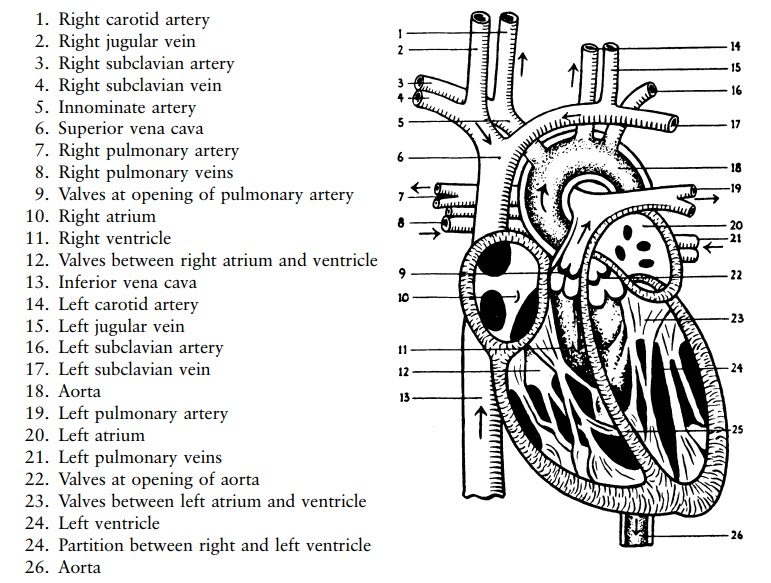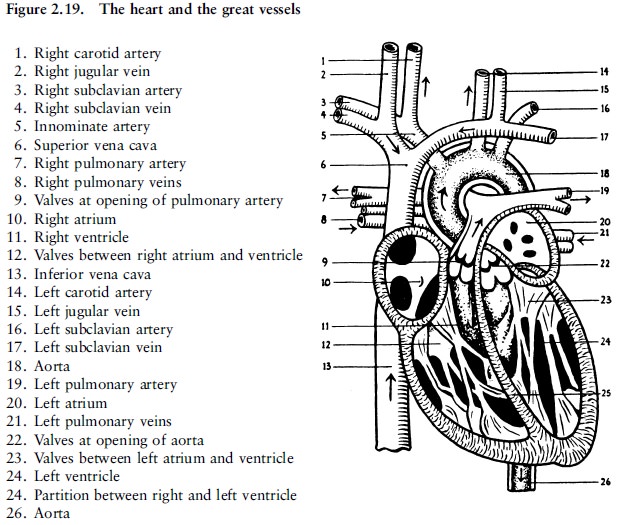Chapter: Forensic Medicine: Basic anatomy and physiology
The heart - Circulation of the blood

The heart (fig 2.19)
The heart lies in the middle of the chest behind
the breast bone and rests on the upper part of the diaphragm. It is conical in
shape, about the size of a closed fist, and lies with two-thirds of its bulk to
the left of the vertical middle line. One can feel it beating in the space
between the fifth and sixth ribs on the left side of the breast bone, a little
to the inside in line with the nipple.
The heart is enclosed in a sac called the
pericardium, and between the heart and the sac is a thin layer of fluid; this
allows heart movement with the least possible amount of friction.
The heart is divided into four chambers: two
upper receiving chambers, the right and the left atria, and two lower expelling
chambers, the right and left ventricles. The walls of the heart are formed of
muscle, and the walls of the ventricles are much thicker that those of the
atria.
A muscular partition completely divides the
heart into a right half and left half, so that no blood can pass directly from
one half of the heart to the other. Each side of the heart therefore has its
atrium or receiving chamber, and its ventricle or expelling chamber, so that
there are two distinct systems of blood circulation in the body.

The first is the circulation (already
described), to and from the tissues of the body generally, nourishing them,
supplying them with pure or arterial blood laden with oxygen, and bringing back
to the heart impure or venous blood laden with carbon dioxide. This circulation
system starts in the left ventricle, follows through the aorta, and brings the
blood back by the large veins to the right atrium. It is called the general or
systemic circulation (fig 2.15, 2.20).

Second, there is the circulation system that
conveys the impure blood to the lungs. In the capillaries the blood gives off
carbon dioxide to the air and takes up oxygen. The blood is then returned to
the heart purified in the sense that it has rid itself of the impurity, carbon
dioxide, and has regained its full load of oxygen. In this system of
circulation the blood leaves the right ventricle by the pulmonary artery, and
returns by the pulmonary veins to the left atrium. It is called pulmonary or
respiratory circulation (fig 2.15).
These two circulation systems are quite distinct
and are different in purpose, the systemic circulation nourishing the tissues,
the respiratory circulation purifying the blood.
On the right side of the heart, then, we find
the great veins bringing the impure blood to the right atrium, from which it
passes to the right ventricle, and from this again, by the pulmonary artery to
the lungs. The right side of the heart therefore contains only impure or venous
blood.
On the left side of the heart we find the
pulmonary veins bringing pure or arterial blood from the lungs to the left
atrium and from there to the left ventricle, from which it passes to the
arteries of the body generally. The left side of the heart therefore contains
only pure or arterial blood.
If we follow the course of a drop of blood in
the right atrium it must pass to the right ventricle and through the pulmonary
circulation to the left atrium, then to the left ventricle and through some
part of the systemic circulation, before it can come back to the right atrium
again.
In summary, all the blood from the lungs passes
to the left atrium and all the blood from the rest of the body passes to the
right atrium.

Related Topics